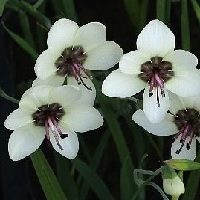
There are 80 species of Geissorhiza,
all from Southern Africa, and most from the winter rainfall areas of the
Western Cape. These dainty perennial plants are part of the Iris family and
mature plants have small pea-like corms. All the Western Cape varieties are
winter growing, with flowers coming out in early spring. The corms need to dry
off during the summer after flowering and growth starts again in the autumn.
The best known plant in this group is Geissorhiza
radians, with very attractive deep blue flowers with red centres.
Gardeners should be able to buy corms in the summer from specialist nurseries
or start these from seed in the summer/autumn. Geissorhiza
inflexa is a beautiful red form, also growing in winter and
flowering in spring. Geissorhiza
tulbaghensis has big white flowers with dark blue centres, and Geissorhiza
aspera has blue/violet flowers, also in spring.
Most Geissorhizas are half hardy, and
need to be protected from hard frosts. They are generally best grown in pots,
as they are small in size, and can be moved around the garden during flowering
and protected over winter. They can be naturalised in grasslands in the very
mildest parts of the UK, but their leaves can easily be mistaken for grass and
they should not be mown, so take care!
Propagation
- By division: New plants can be created by removing the offsets from mature
corms during the dormant period in the summer.
- By seed: Seeds
should be sown in summer/autumn in trays of well drained seed compost
with a very light sprinkling of vermiculite or fine sand. Immerse the tray
in water when moisture is needed. Keep at 10-20°C and germination takes
4-6 weeks, sometimes longer. Seedlings should be grown on into the second
season and given a liquid feed every couple of weeks to help a small corm
to develop, and then planted into final pots. Flowering starts in the
second season in ideal conditions, otherwise in the third season.
Care
Geissorhizas grow best in sun or part
shade and in well drained soil. Corms can be left in their pots after flowering
and allowed to dry out or lifted and stored in a cool dry place. Dust the corms
with antifungal powder. Replant in the autumn and keep watered during the
winter, when the plants should be growing, and protected from hard frost.
Protect young plants from slugs and snails and consider spraying with an
insecticide to deter thrips and aphids. |
|